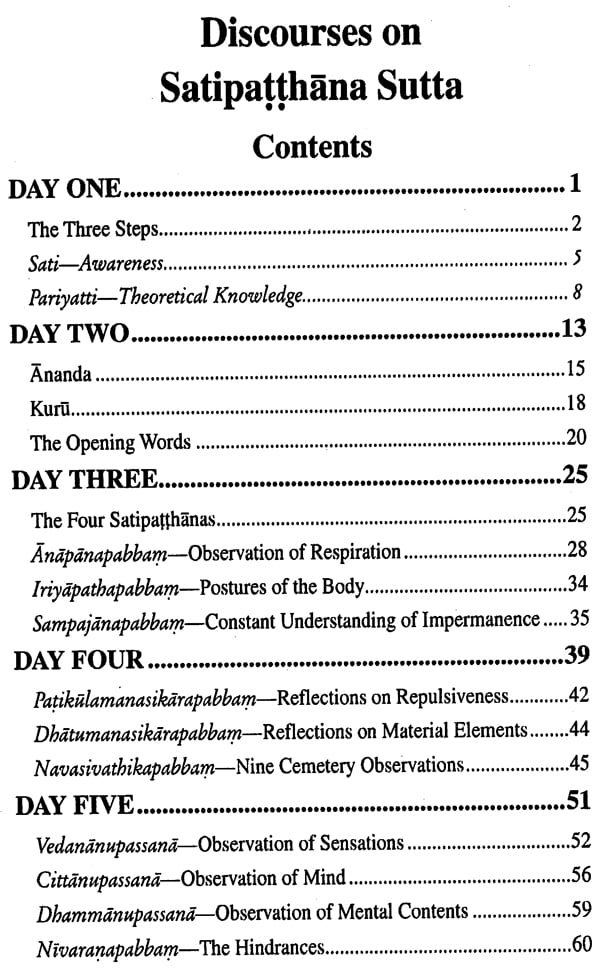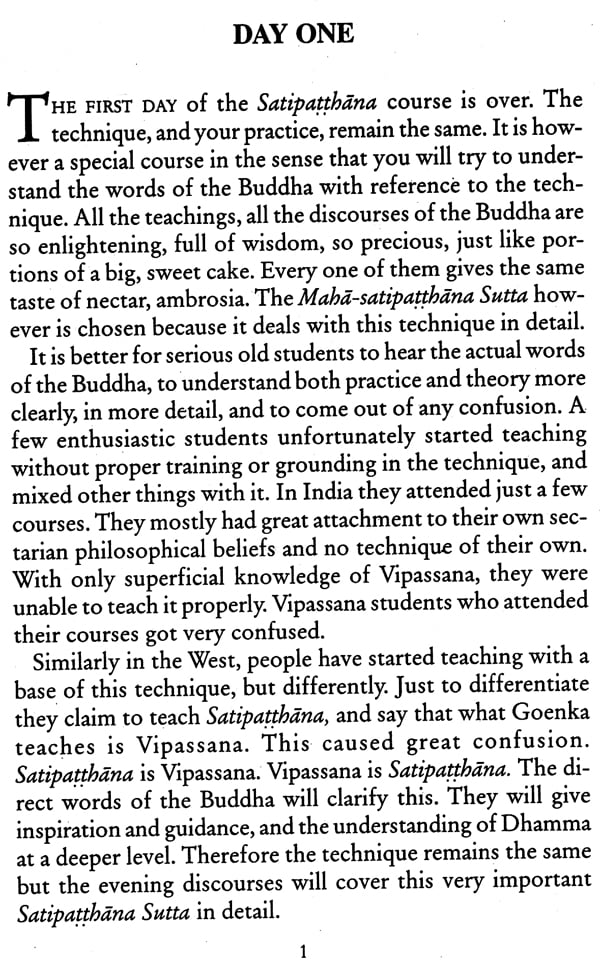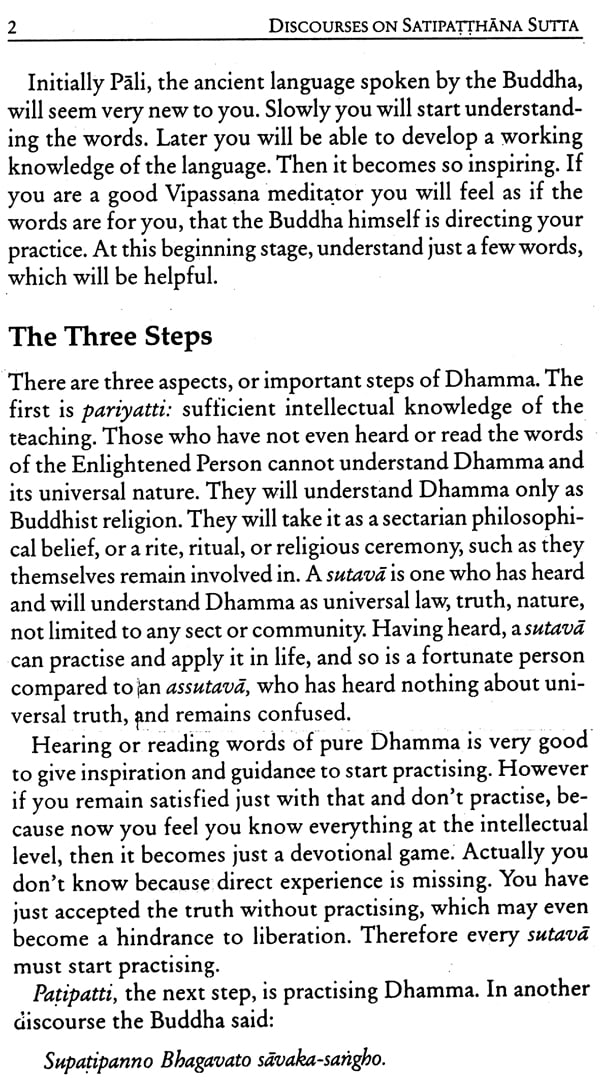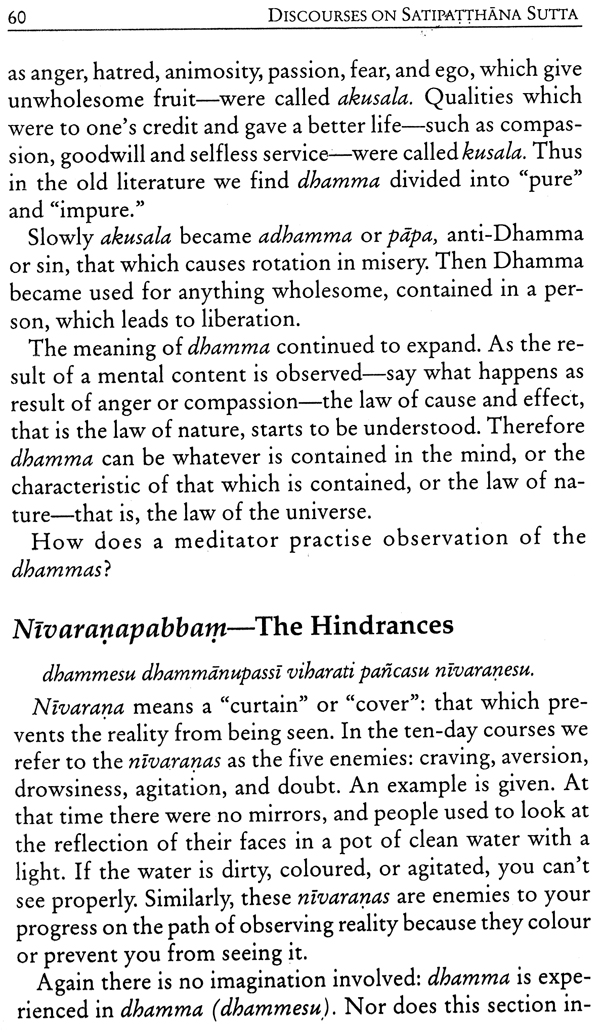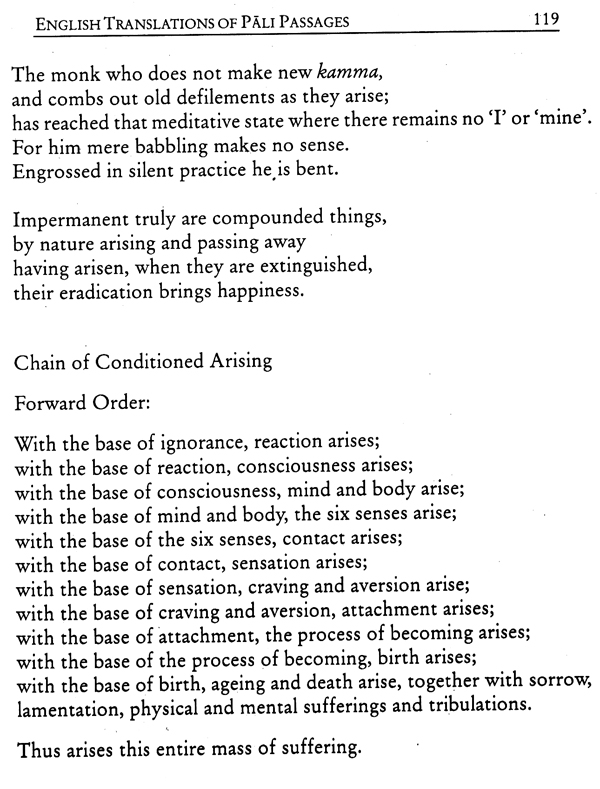
Discourses on Satipatthana Sutta
Book Specification
| Item Code: | NAW225 |
| Author: | S.N. Goenka |
| Publisher: | Vipassana Research Institute |
| Language: | English |
| Edition: | 2017 |
| ISBN: | 8174142010 |
| Pages: | 124 |
| Cover: | PAPERBACK |
| Other Details | 8.50 X 5.50 inch |
| Weight | 130 gm |
Book Description
Satyanarayan Goenka the master of Vipassana Meditation, Jearnt the technique from Sayagyi U Ba Khin who belonged to a long lineage of celebrated Mipwanduachers Goenkaji and his assistant teachers teach Vipassana in residential Ten-day courses organised around the world.
Though Vipassana and Satipatthana are synonymous, in order to clear any misunderstanding in this regard, special Satipatthana courses are conducted in which Goenkaji expounds the Sutta in evening discourses which enable the meditators to get direct inspiration from the words of the Buddha. Each chapter in this book is condensed from these daily evening discourses. "Liberation can only be gained by practice, never by mere discussion." These words of Goenkaji should remind the reader that the purpose of theory(pariyatti) is to support and inspire the practice(patipattt), and not to supplement it.
S.N. Goenka, or Goenkaji as he is widely and respectfully referred to, is well known in numerous countries of the world as a master teacher of meditation. He received the technique that he reaches in the 1950’s from Sayagyi U Ba Khin of Burma, who in turn received it from Saya Thet, who received it in turn from the venerable monk, Ledi Sayadaw, who in turn received it from his own teacher in along line of teachers descended directly from the Buddha. The achievement of this line of teachers in preserving the technique through such a long period of time is extraordinary, and a cause for gratitude in those who practise it. Now, in a world hungry for inner peace, there has been an extraordinary spread of the technique in Goenkaji’s lifetime: at the time of this writing meditation courses are given in 55 meditation centres as well as many temporary campsites in India and around the world, attracting about 40,000 people annually, a number which is growing each year.
In spite of his magnetic personality and the enormous success of his teaching methods, Goenkayi gives all credit for his success to the efficacy of Dhamma itself. He has never sought to play the role of a guru or to found any kind of sect, cult or religious organisation.
When teaching the technique he never omits to say that he received it from the Buddha through a chain of teachers down to his own teacher, and his gratitude to them for the benefits that he has personally gained in his own meditation is evident. At the same time, he continually emphasises that he does not teach Buddhism or any kind of "ism," and that the technique that he teaches is universal, for people from any religious or philosophical background or belief.
The standard meditation course in this tradition is a residential course of ten days’ duration. Participants commit themselves to staying on the course site for the full ten days, observing a rigorous timetable, maintaining complete silence among themselves. for the first nine days. At the beginning of the course, they take the five precepts as given by the Buddha to householders: to refrain from killing, to refrain from stealing, to refrain from telling lies, to refrain from sexual misconduct (which involves the maintenance of complete celibacy for the duration of the course), and to refrain from taking any intoxicants. They start with the practice of Andpana meditation, that is, the observation of the natural breath. On the fourth day, when some concentration has been gained, they switch to the practice of Vipassana, the systematic observation of the entire mind: matter phenomenon through the medium of bodily sensations. On the last full day, they practise Metta-bhavana, that is, loving kindness, or sharing the merits that they have gained with others.
Although his family was from India, Goenkaji was brought up in Burma, where he learnt the technique from his teacher Sayagy U Ba Khin. After being authorised as a teacher by U Ba Khin he left Burma in 1969 in response to his mother’s illness, to give a ten-day course to his parents and twelve others in Bombay. The inspiration that he imparted and the extraordinary results of his teaching led to many more such courses, first in campsites around India and then later in centres as these began to spring up. From 1979 onwards he also started giving courses outside India, notably in Sri Lanka, Thailand, Nepal, France, England, North America, Japan, Australia, and New Zealand. All of these areas today have one or more centres.
Unfortunately around this time confusion arose among some meditators as to how to practise Vipassana. The question arose as to what was Vipassana and what was Satipatthana. In tact Vipassana and Satipatthana are synonymous. They are the same.
In order to enable meditators to work directly with the Buddha’s words and to dispel this confusion, Goenkaji gave the first Satipatthana Sutta course at Dhammagin, the main centre near Bombay, from 16 to , 22 December 1981. The discipline and timetable of a ten-day course remained, but the participants could study the text of the Sutta in the break periods, if they wished. Goenkaji’s evening discourses explained and expanded on the Sutta. In this way pariyatti (the theoretical study of Dhamma) and patipatti (the actual practice of Dhamma) were most beneficially combined.
Each of the chapters of this book is a condensed version of the daily evening discourse given by S.N. Goenka during a Satipatthana Sutta course held at Dhamma Bhimi, Blackheath, Australia, in November, 1990. The book is intended as a companion volume to the Maha-satipatthana Sutta, The Great Discourse on the Estab- lishing of Awareness (VRI, 1998), with its introduction and notes, published by the Vipassana Research Institute. That volume con- tains the full text of the Sutta and is used as a handbook by medi- tation students who are attending the course. The condensed discourses in this book contain only short excerpts from the Sutta, and it is not intended to be used on the course, where students are able to hear the original discourses directly by means of videotape. It may, however, serve as an aid to meditators after the course as a review of the content, as an aid to further study of the texts for scholars, and to assist with translation and better understanding for the benefit of those whose mother tongue is not English.
"I iberation can only be gained by practice, never by mere discussion." These words of Goenkaji give a fitting background to the origin and reason for these discourses and for the Satipatthana Sutta course itself.
Goenkaji has always emphasised the importance of the actual practice of meditation; theory and study are understood as a support to the practice. In the Satipatthana discourses he warns of how unfortunate it would be if a centre became devoted only to the study of theory. On Satipatthana courses, as with the ten-day courses, the full meditation timetable 1s followed, the discourses being restricted just to one period in the evening. This means that the participants can use the theory as a foundation from which to investigate and experience realities inside themselves directly, rather than being tempted to get caught up in mere intellectual debates about it. Not that intellectual study is discouraged, but as Goenkaji emphasises, theory and practice should go together. Similarly, on a ten-day course, the teachings in the discourses proceed from sila (morality), to samadhi (mastery of the mind), to parivia (wisdom through insight) as the meditators are introduced to each at a practical level.
A prerequisite for the Satipatthana course in this tradition is the completion of three ten-day courses, regular daily practice, and at least a minimum maintenance of sila, by keeping the five moral precepts. It is noteworthy that the Sutta itself contains no mention of sila. Goenkaji explains the background in the opening discourse given on Day Two: the Sutta was given to the people of Kuru, who already had a strong background of sila, going back generations. To talk of sila to them was unnecessary; its importance was already understood and assumed. It is also important today that meditators taking this course and working with this Sutta have at least a basic understanding and practice of sila.
Without this foundation of morality, it is impossible for them to go to sufficient depth in their practice to work effectively with the teaching in the Swtta. Many of the original audience of the Sutta were already highly developed in their own meditation, needing very little guidance to be able to reach higher stages. While such attainments are not necessarily expected today, a requirement of the course is that the Satipatthdna students at least have some solid experience in this meditation, as well as familiarity with the ten-day discourses.
It was also no coincidence that Goenkaji’s teaching of the first course in the Satipatthdna Sutta at Dhammagiri was immediately followed by his teaching of a one-month Vipassana course. The further understanding gained from attending a Satipatthana course forms an essential base for practice during a long course, and is in fact a requirement for taking long courses in this tradition. This understanding forms a very important and helpful guide for the meditator during the extended solitude spent in practice during a long course. Additionally, the long course discourses refer frequently to the teachings of this important Sutta, which are also echoed in many other suttas.
